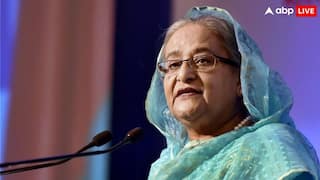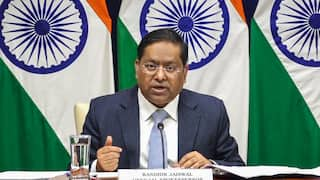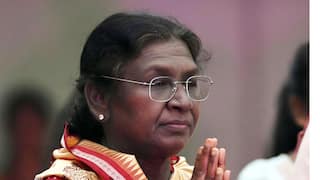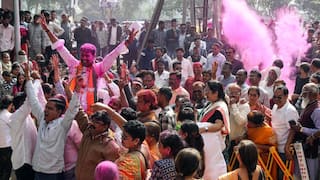Jurassic Era Giants Living In Seas Were Twice As Big As A Killer Whale: Study
An animal that was a pliosaur (large, carnivorous marine reptile) or closely related to a pliosaur species probably grew up to a size of 14.4 metres, according to the study.

Jurassic era giants living in seas were twice as large as killer whales, a new study has suggested. An animal that was a pliosaur or closely related to a pliosaur species probably grew up to a size of 14.4 metres, according to the study.
Pliosaurs were large, carnivorous marine reptiles with massive heads similar to crocodiles, short necks and streamlined body shapes living about 200 million to 65.5 million years ago. They had a short tail, and four flippers, which served as powerful paddles to help them wade through water.
The study, led by palaeontologists at the University of Portsmouth, was recently published in the journal Proceedings of the Geologists' Association.
More than two decades ago, a BBC television documentary series titled 'Walking with Dinosaurs' portrayed Liopleurodon, a pliosaur that lived in present-day England and northern France, as a 25-metre-long reptile. Over the years, it has been debated that the size of the pliosaur was overestimated. Experts said that the maximum size Liopleurodon reached as an adult was probably six metres.
However, the lead author on the new paper has now claimed that he got the size of Liopleurodon "horrendously wrong". In a statement released by the University of Portsmouth, lead author David Martill said he was a consultant for the BBC's pilot programme 'Cruel Sea', and that he based his calculations on some fragmentary material which suggested a Liopleurodon could grow to a length of 25 metres, but the evidence was scant, and it caused a lot of controversy at that time.
Martill further said that the size estimate on the BBC back in 1999 was overdone, but now, researchers have some evidence that is much more reliable after a serendipitous discovery of four enormous vertebrae.
According to the University of Portsmouth, Megan Jacobs, the co-author on the paper, was clicking photographs of an ichthyosaur (extremely aquatic reptile similar to porpoises) skeleton at Abingdon County Hall Museum in London, while Martill was looking through drawers of fossils. This is when Martill found a large vertebra, and was excited when he got to know that the curator had three more vertebrae in storage.
Four isolated cervical vertebrae probably belonged to a pliosaur
The study said that the four isolated cervical vertebrae have been identified as likely belonging to a pliosaurid pleisiosaurian sauropterygian. Sauropterygians were aquatic reptiles that lived during the Mesozoic Era, 251 million to 66 million years ago, and included plesiosaurs. Sauropterygian was a superorder, plesiosauria was an order, and pliosauroidea was a suborder.
On account of the location of tall rib facets on the centrum or ventral body, and the shortness of the vertebrae relative to width and height, the authors deduced that the vertebrae belonged to a pliosaur. Pliosaurs also had a platycoelous nature, which means they were flat ventrally (on the underside) and convex dorsally (on the upper side).
The vertebrae had a maximum width of 269 millimetres, maximum height of 222 millimetres, and a maximum length of 103 millimetres.
ALSO READ | What Did Neanderthals And Ancient Humans Hunt And Eat? Tooth Enamel Provides Clues
How was the length of the pliosaur determined?
Through simple scaling, and comparisons with cervical vertebrae of Mid Jurassic (174.1 million to 163.5 million years ago) pliosaurs Peloneustes and Liopleurodon, and the Early Cretaceous (145 million years ago to 100.5 million years ago) Stenorhynchosaurus (pliosaurs with narrow snouts) and Sachicasaurus (a pliosaur that lived in waters around South America), the authors found that the total body length of the pliosaur to which the vertebrae belonged was somewhere between 9.8 metres and 14.4 metres. They noted that the true length was likely towards the higher end of the range.
The authors said that on the basis of the described material, a genus and species cannot be confidently determined, but the vertebrae likely belong to a Pliosaurus species of a similar animal.
What were the teeth of pliosaurs like? What did they feed on?
Martill said in the statement that pliosaurs were very fearsome animals swimming in the seas that covered Oxfordshire 145 to 152 million years ago, and had a massive skull with huge protruding teeth like daggers. The teeth were as big as those of T. rex.
Martill said that pliosaurs were more powerful than T. rex, and were at the top of the marine food chain.
Pliosaurs probably preyed on ichthyosaurs, long-necked plesiosaurs, and maybe even smaller marine crocodiles, simply by biting them in half and taking chunks off them, Martill said.
The ichthyosaurs bones on display in The Etches Collection in Dorset, England, have bite marks, Martill stated.
During temporary excavations at Warren Farm in the River Thames Valley in Oxfordshire, the vertebrae were discovered for the first time. The vertebrae come from the Kimmeridge Clay Formation, which is a deposit dating back to the Late Jurassic, and is around 152 million years old.







































